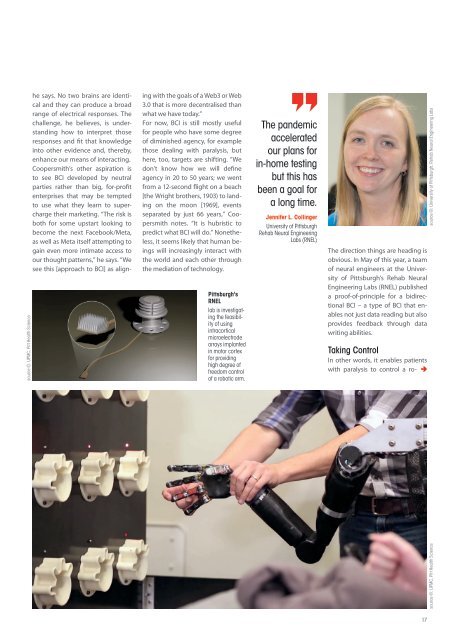Smart Industry No.1 2022
Smart Industry No.1 2022 - The IoT Business Magazine - powered by Avnet Silica
Smart Industry No.1 2022 - The IoT Business Magazine - powered by Avnet Silica
Create successful ePaper yourself
Turn your PDF publications into a flip-book with our unique Google optimized e-Paper software.
source ©: UPMC, Pitt Health Science<br />
he says. No two brains are identical<br />
and they can produce a broad<br />
range of electrical responses. The<br />
challenge, he believes, is understanding<br />
how to interpret those<br />
responses and fit that knowledge<br />
into other evidence and, thereby,<br />
enhance our means of interacting.<br />
Coopersmith’s other aspiration is<br />
to see BCI developed by neutral<br />
parties rather than big, for-profit<br />
enterprises that may be tempted<br />
to use what they learn to supercharge<br />
their marketing. “The risk is<br />
both for some upstart looking to<br />
become the next Facebook/Meta,<br />
as well as Meta itself attempting to<br />
gain even more intimate access to<br />
our thought patterns,” he says. “We<br />
see this [approach to BCI] as aligning<br />
with the goals of a Web3 or Web<br />
3.0 that is more decentralised than<br />
what we have today.”<br />
For now, BCI is still mostly useful<br />
for people who have some degree<br />
of diminished agency, for example<br />
those dealing with paralysis, but<br />
here, too, targets are shifting. “We<br />
don’t know how we will define<br />
agency in 20 to 50 years; we went<br />
from a 12-second flight on a beach<br />
[the Wright brothers, 1903) to landing<br />
on the moon [1969], events<br />
separated by just 66 years,” Coopersmith<br />
notes. “It is hubristic to<br />
predict what BCI will do.” Nonetheless,<br />
it seems likely that human beings<br />
will increasingly interact with<br />
the world and each other through<br />
the mediation of technology.<br />
Pittsburgh's<br />
RNEL<br />
lab is investigating<br />
the feasibility<br />
of using<br />
intracortical<br />
microelectrode<br />
arrays implanted<br />
in motor cortex<br />
for providing<br />
high degree of<br />
freedom control<br />
of a robotic arm.<br />
The pandemic<br />
accelerated<br />
our plans for<br />
in-home testing<br />
but this has<br />
been a goal for<br />
a long time.<br />
Jennifer L. Collinger<br />
University of Pittsburgh<br />
Rehab Neural Engineering<br />
Labs (RNEL)<br />
The direction things are heading is<br />
obvious. In May of this year, a team<br />
of neural engineers at the University<br />
of Pittsburgh’s Rehab Neural<br />
Engineering Labs (RNEL) published<br />
a proof-of-principle for a bidirectional<br />
BCI – a type of BCI that enables<br />
not just data reading but also<br />
provides feedback through data<br />
writing abilities.<br />
Taking Control<br />
In other words, it enables patients<br />
with paralysis to control a rosource<br />
©: UPMC, Pitt Health Science<br />
source ©: University of Pittsburgh, Rehab Neural Engineering Labs<br />
17
















